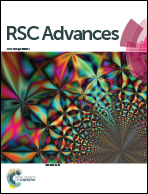In situ crosslinked PVA–PEI polymer binder for long-cycle silicon anodes in Li-ion batteries
Abstract
A novel polymer binder, synthesized via in situ thermal cross-linking of water-soluble polyvinyl alcohol (PVA) and poly(ethylene imine) (PEI) precursor, is applied as a functional network binder to enhance the electrochemical performance of a silicon anode. The Si anode with PVA–PEI binder exhibits high specific capacity (3072.9 mA h g−1) in the initial cycle, high initial coulombic efficiency of 83.8% and excellent long-term cycling stability (1063.1 mA h g−1 after 300 cycles). Furthermore, the Si anode containing PVA–PEI binder also exhibits excellent rate performance, reaching a high specific capacity of 1590 mA h g−1 even at high current density of 10 A g−1. These outstanding electrochemical properties are ascribed to the reversibly-deformable polymer network and the binder's strong adhesion to the silicon particles. This low-cost and eco-friendly polymer binder has great potential to be used for silicon anodes in next generation Li-ion batteries.


 Please wait while we load your content...
Please wait while we load your content...